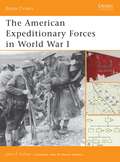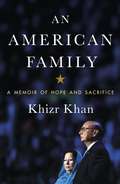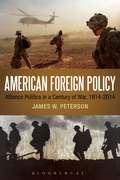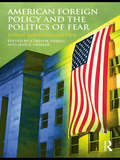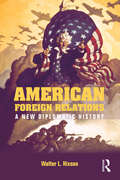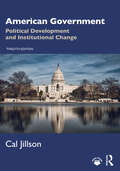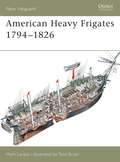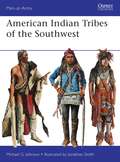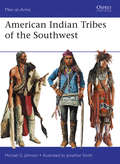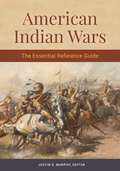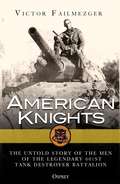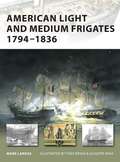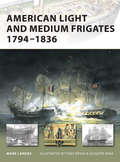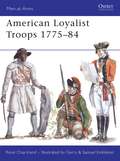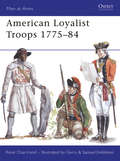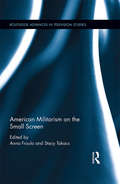- Table View
- List View
The American Expeditionary Forces in World War I (Battle Orders #6)
by John VotawUpon the entry of the United States into World War I, the American Expeditionary Forces (AEF) were created by the War Department on short notice from existing units, filled up with men from the training camps and deployed with only their personal weapons and equipment. The US Army was not prepared for combat in France, and the remarkable achievement of the AEF's commanding officer, John J Pershing, was the creation of an American field army, built and nurtured from the bottom up. This book details the organizational structure, training and doctrine of the AEF and illustrates how it came to make a significant contribution to Allied victory in World War I.
An American Family: A Memoir Of Hope And Sacrifice
by Khizr Khan'Khan's aspirational memoir reminds us all why Americans should welcome newcomers from all lands' Kirkus ReviewsIn fewer than three hundred words, Khizr Khan electrified viewers around the world when he took the stage at the 2016 Democratic National Convention. And when he offered to lend Donald Trump his own much-read and dog-eared pocket Constitution, his gesture perfectly encapsulated the feelings of millions. But who was that man, standing beside his wife, extolling the promises and virtues of the U.S. Constitution?In this urgent and timeless immigrant story, we learn that Khizr Khan has been many things. He was the oldest of ten children born to farmers in Pakistan, and a curious and thoughtful boy who listened rapt as his grandfather recited Rumi beneath the moonlight. He was a university student who read the Declaration of Independence and was awestruck by what might be possible in life. He was a hopeful suitor, trying to win the heart of a woman far out of his league. He was a brilliant and diligent young family man who worked two jobs to save enough money to put himself through Harvard Law School. He was a loving father who tragically lost his son, an Army captain killed while protecting his base camp in Iraq. He was and is a patriot, and a fierce advocate for the rights, dignities and values enshrined in the American system.An American Family shows us who Khizr Khan and millions of other American immigrants are, and why-especially in these tumultuous times-we must not be afraid to step forward for what we believe in when it matters most.
American Foreign Policy: Alliance Politics in a Century of War, 1914-2014
by James W. PetersonThe text aims to uncover the roots of the United States' near perpetual involvement in war since the beginning of WWI in 1914. Using alliance politics as the main framework of analysis, it offers a new interpretation that contrasts with the traditional views that war is an interruption of the American foreign policy emphasis on diplomacy. Instead, it posits that war has been the norm during the past century while peaceful interludes were but a time of respite and preparation for the next conflict. After a thorough discussion of the concepts of alliance building and the containment doctrine, the work then addresses such themes as the alliance networks used to confront German and Japanese powers during the early 20th century wars, the role of alliances in containing the Soviet Union during the Cold War, the creation of alliances to restrict and defeat rogue state powers, and whether they were useful when dealing with the challenges posed by terrorism in the post-9/11 world. Each chapter features case studies, a summary, references, and web links. In addition, the book utilizes primary sources, such as U.S. Department of Defense and State documents and presidential statements. An exhaustive study of containment and alliance, this text will be an essential resource for anyone studying U.S. foreign policy, international relations, and national security.
American Foreign Policy: Alliance Politics in a Century of War, 1914-2014
by James W. PetersonThe text aims to uncover the roots of the United States' near perpetual involvement in war since the beginning of WWI in 1914. Using alliance politics as the main framework of analysis, it offers a new interpretation that contrasts with the traditional views that war is an interruption of the American foreign policy emphasis on diplomacy. Instead, it posits that war has been the norm during the past century while peaceful interludes were but a time of respite and preparation for the next conflict. After a thorough discussion of the concepts of alliance building and the containment doctrine, the work then addresses such themes as the alliance networks used to confront German and Japanese powers during the early 20th century wars, the role of alliances in containing the Soviet Union during the Cold War, the creation of alliances to restrict and defeat rogue state powers, and whether they were useful when dealing with the challenges posed by terrorism in the post-9/11 world. Each chapter features case studies, a summary, references, and web links. In addition, the book utilizes primary sources, such as U.S. Department of Defense and State documents and presidential statements. An exhaustive study of containment and alliance, this text will be an essential resource for anyone studying U.S. foreign policy, international relations, and national security.
American Foreign Policy and The Politics of Fear: Threat Inflation since 9/11 (Routledge Global Security Studies)
by A. Trevor Thrall Jane K. CramerThis edited volume addresses the issue of threat inflation in American foreign policy and domestic politics. The Bush administration's aggressive campaign to build public support for an invasion of Iraq reheated fears about the president's ability to manipulate the public, and many charged the administration with 'threat inflation', duping the news media and misleading the public into supporting the war under false pretences. Presenting the latest research, these essays seek to answer the question of why threat inflation occurs and when it will be successful. Simply defined, it is the effort by elites to create concern for a threat that goes beyond the scope and urgency that disinterested analysis would justify. More broadly, the process concerns how elites view threats, the political uses of threat inflation, the politics of threat framing among competing elites, and how the public interprets and perceives threats via the news media. The war with Iraq gets special attention in this volume, along with the 'War on Terror'. Although many believe that the Bush administration successfully inflated the Iraq threat, there is not a neat consensus about why this was successful. Through both theoretical contributions and case studies, this book showcases the four major explanations of threat inflation -- realism, domestic politics, psychology, and constructivism -- and makes them confront one another directly. The result is a richer appreciation of this important dynamic in US politics and foreign policy, present and future. This book will be of much interests to students of US foreign and national security policy, international security, strategic studies and IR in general. Trevor Thrall is Assistant Professor of Political Science and directs the Master of Public Policy program at the University of Michigan - Dearborn. Jane Kellett Cramer is an Assistant Professor of Political Science at the University of Oregon.
American Foreign Policy and The Politics of Fear: Threat Inflation since 9/11 (Routledge Global Security Studies)
by A. Trevor Thrall Jane K. CramerThis edited volume addresses the issue of threat inflation in American foreign policy and domestic politics. The Bush administration's aggressive campaign to build public support for an invasion of Iraq reheated fears about the president's ability to manipulate the public, and many charged the administration with 'threat inflation', duping the news media and misleading the public into supporting the war under false pretences. Presenting the latest research, these essays seek to answer the question of why threat inflation occurs and when it will be successful. Simply defined, it is the effort by elites to create concern for a threat that goes beyond the scope and urgency that disinterested analysis would justify. More broadly, the process concerns how elites view threats, the political uses of threat inflation, the politics of threat framing among competing elites, and how the public interprets and perceives threats via the news media. The war with Iraq gets special attention in this volume, along with the 'War on Terror'. Although many believe that the Bush administration successfully inflated the Iraq threat, there is not a neat consensus about why this was successful. Through both theoretical contributions and case studies, this book showcases the four major explanations of threat inflation -- realism, domestic politics, psychology, and constructivism -- and makes them confront one another directly. The result is a richer appreciation of this important dynamic in US politics and foreign policy, present and future. This book will be of much interests to students of US foreign and national security policy, international security, strategic studies and IR in general. Trevor Thrall is Assistant Professor of Political Science and directs the Master of Public Policy program at the University of Michigan - Dearborn. Jane Kellett Cramer is an Assistant Professor of Political Science at the University of Oregon.
American Foreign Relations: A New Diplomatic History
by Walter L. HixsonAmerican Foreign Relations: A New Diplomatic History is a compelling narrative history of American foreign policy from the early settlement of North America to the present. In addition to economic and strategic motives, Walter L. Hixson integrates key cultural factors—including race, gender, and religion—into the story of American foreign policy. He demonstrates how these factors played a vital role in shaping the actions of the United States in world affairs. Beginning with the history of warfare and diplomacy between indigenous peoples and Europeans before the establishment of the United States, this book shows the formative influence of settler colonialism on the country’s later foreign policy and the growth of American empire. Clearly written and comprehensive, the book features: Extensive illustrations, with over 100 images and maps Primary documents in each chapter, showcasing the perspectives of historical actors "Interpreting the Past" features that explore how historians’ understanding of events has changed over time Selected bibliographies of key resources for further research in each chapter In one concise volume, American Foreign Relations covers the full sweep of American foreign policy from the colonial period to the present day. It is an essential introduction for anyone seeking to understand the history of America’s role in the world.
American Foreign Relations: A New Diplomatic History
by Walter L. HixsonAmerican Foreign Relations: A New Diplomatic History is a compelling narrative history of American foreign policy from the early settlement of North America to the present. In addition to economic and strategic motives, Walter L. Hixson integrates key cultural factors—including race, gender, and religion—into the story of American foreign policy. He demonstrates how these factors played a vital role in shaping the actions of the United States in world affairs. Beginning with the history of warfare and diplomacy between indigenous peoples and Europeans before the establishment of the United States, this book shows the formative influence of settler colonialism on the country’s later foreign policy and the growth of American empire. Clearly written and comprehensive, the book features: Extensive illustrations, with over 100 images and maps Primary documents in each chapter, showcasing the perspectives of historical actors "Interpreting the Past" features that explore how historians’ understanding of events has changed over time Selected bibliographies of key resources for further research in each chapter In one concise volume, American Foreign Relations covers the full sweep of American foreign policy from the colonial period to the present day. It is an essential introduction for anyone seeking to understand the history of America’s role in the world.
American Government: Political Development and Institutional Change
by Cal JillsonHow politics in America works today, how it got that way, and how it’s likely to change through reform—these are the themes that pervade every chapter of Cal Jillson’s highly lauded American Government: Political Development and Institutional Change. Even in the midst of current challenges, America’s past is present in all aspects of the contemporary political system. Jillson uses political development and the dynamics of change as a thematic tool to help students understand how politics works now—and how institutions, participation, and policies have evolved over time to produce the contemporary political environment. In addition, Jillson helps students think critically about how American democracy might evolve further, focusing in every chapter on reform and further change. New to the 12th Edition: Assesses the characteristics and results of the Trump administration and the policy and tonal changes of the early Biden adminstration. Describes numerous ways in which the American political system has been affected by the Covid-19 pandemic Assesses the implications of the January 6, 2021 attack on the Capitol and what it implies for our political culture and partisan politics. Assesses the implication of "fake news" and "the move to mobile" for our politics. Explores the evidence for increasing polarization in public opinion, voting behavior, and the work of Congress and the courts.. Details the impact that the Russian invasion of Ukraine had on President Biden’s attempt to rebuild U.S. national security alliances.
American Government: Political Development and Institutional Change
by Cal JillsonHow politics in America works today, how it got that way, and how it’s likely to change through reform—these are the themes that pervade every chapter of Cal Jillson’s highly lauded American Government: Political Development and Institutional Change. Even in the midst of current challenges, America’s past is present in all aspects of the contemporary political system. Jillson uses political development and the dynamics of change as a thematic tool to help students understand how politics works now—and how institutions, participation, and policies have evolved over time to produce the contemporary political environment. In addition, Jillson helps students think critically about how American democracy might evolve further, focusing in every chapter on reform and further change. New to the 12th Edition: Assesses the characteristics and results of the Trump administration and the policy and tonal changes of the early Biden adminstration. Describes numerous ways in which the American political system has been affected by the Covid-19 pandemic Assesses the implications of the January 6, 2021 attack on the Capitol and what it implies for our political culture and partisan politics. Assesses the implication of "fake news" and "the move to mobile" for our politics. Explores the evidence for increasing polarization in public opinion, voting behavior, and the work of Congress and the courts.. Details the impact that the Russian invasion of Ukraine had on President Biden’s attempt to rebuild U.S. national security alliances.
American Heavy Frigates 1794–1826 (New Vanguard)
by Tony Bryan Mark LardasBy 1805 the 44-gun frigate was probably viewed as a failed experiment whilst the 38-gun frigate was viewed as the vessel of the future. Ten years later every navy was building 44-gun frigates and today it is viewed as the symbol of the Napoleonic-era cruiser. This remarkable transformation resulted from the performance of three ships – the Constitution, United States, and President – 44-gun frigates built for the United States Navy between 1794 and 1799. Their victories in the naval War of 1812, as well as their performance against the Barbary Pirates, caught the imagination of the world – and spurred all navies into re-examining the class.
American Heavy Frigates 1794–1826 (New Vanguard #79)
by Tony Bryan Mark LardasBy 1805 the 44-gun frigate was probably viewed as a failed experiment whilst the 38-gun frigate was viewed as the vessel of the future. Ten years later every navy was building 44-gun frigates and today it is viewed as the symbol of the Napoleonic-era cruiser. This remarkable transformation resulted from the performance of three ships – the Constitution, United States, and President – 44-gun frigates built for the United States Navy between 1794 and 1799. Their victories in the naval War of 1812, as well as their performance against the Barbary Pirates, caught the imagination of the world – and spurred all navies into re-examining the class.
American Indian Tribes of the Southwest (Men-at-Arms)
by Jonathan Smith Michael G JohnsonThis focuses on the history, costume, and material culture of the native peoples of North America. It was in the Southwest – modern Arizona, New Mexico, and parts of California and other neighboring states – that the first major clashes took place between 16th-century Spanish conquistadors and the indigenous peoples of North America. This history of contact, conflict, and coexistence with first the Spanish, then their Mexican settlers, and finally the Americans, gives a special flavor to the region. Despite nearly 500 years of white settlement and pressure, the traditional cultures of the peoples of the Southwest survive today more strongly than in any other region. The best-known clashes between the whites and the Indians of this region are the series of Apache wars, particularly between the early 1860s and the late 1880s. However, there were other important regional campaigns over the centuries – for example, Coronado's battle against the Zuni at Hawikuh in 1540, during his search for the legendary "Seven Cities of Cibola†?; the Pueblo Revolt of 1680; and the Taos Revolt of 1847 – and warriors of all of these are described and illustrated in this book.
American Indian Tribes of the Southwest (Men-at-Arms #488)
by Jonathan Smith Michael G JohnsonThis focuses on the history, costume, and material culture of the native peoples of North America. It was in the Southwest – modern Arizona, New Mexico, and parts of California and other neighboring states – that the first major clashes took place between 16th-century Spanish conquistadors and the indigenous peoples of North America. This history of contact, conflict, and coexistence with first the Spanish, then their Mexican settlers, and finally the Americans, gives a special flavor to the region. Despite nearly 500 years of white settlement and pressure, the traditional cultures of the peoples of the Southwest survive today more strongly than in any other region. The best-known clashes between the whites and the Indians of this region are the series of Apache wars, particularly between the early 1860s and the late 1880s. However, there were other important regional campaigns over the centuries – for example, Coronado's battle against the Zuni at Hawikuh in 1540, during his search for the legendary "Seven Cities of Cibola†?; the Pueblo Revolt of 1680; and the Taos Revolt of 1847 – and warriors of all of these are described and illustrated in this book.
American Indian Wars: The Essential Reference Guide
by Justin D. MurphyProviding an indispensable overview of the American Indian Wars, this book focuses on Native American tribes and warriors and their varying responses to the onslaught of European colonists and American settlers in the centuries following contact.This work provides an overview of the Indian Wars from the arrival of Europeans until 1890. The work focuses primarily on Native American tribes and warriors and their role in battles and campaigns against other Native Americans and Europeans/Americans, while also including key European/American leaders and soldiers as well as treaties between Native Americans and Europeans/Americans. The introduction provides a broad overview of the Indian Wars and also considers whether the Indian Wars should be considered genocide. The bibliography focuses on the most important works published on the Indian Wars. Each entry also includes a list of references for readers to consult. The work also includes a collection of primary source documents that span the entire time period.
American Indian Wars: The Essential Reference Guide
by Justin D. MurphyProviding an indispensable overview of the American Indian Wars, this book focuses on Native American tribes and warriors and their varying responses to the onslaught of European colonists and American settlers in the centuries following contact.This work provides an overview of the Indian Wars from the arrival of Europeans until 1890. The work focuses primarily on Native American tribes and warriors and their role in battles and campaigns against other Native Americans and Europeans/Americans, while also including key European/American leaders and soldiers as well as treaties between Native Americans and Europeans/Americans. The introduction provides a broad overview of the Indian Wars and also considers whether the Indian Wars should be considered genocide. The bibliography focuses on the most important works published on the Indian Wars. Each entry also includes a list of references for readers to consult. The work also includes a collection of primary source documents that span the entire time period.
American Knights: The Untold Story of the Men of the Legendary 601st Tank Destroyer Battalion (General Military Ser.)
by Victor Tory† FailmezgerAs the war began to swing in favour of the Allies, it became clear that no final defeat of the Third Reich would be possible until the armoured monsters of the Panzerwaffe were defeated. But who would, or even could, take on the mighty Tigers and Panthers, just a handful of which could stop entire formations in their tracks? The answer lay with the formation of a new type of unit, the Tank Destroyer Battalion. This is the story of the men and machines that made up the very first Tank Destroyer Battalion, the 601st, from their unique training and formation, to the final, desperate battles in the heart of Nazi Germany. Packed with rare material, letters, diaries and previously unpublished photographs, and now available in paperback, this is an intense and intimate chronicle of the men who fought the Panzers in an astonishing 10 campaigns and 546 days of lethal combat.
American Knights: The Untold Story of the Men of the Legendary 601st Tank Destroyer Battalion
by Victor Tory† FailmezgerAs the war began to swing in favour of the Allies, it became clear that no final defeat of the Third Reich would be possible until the armoured monsters of the Panzerwaffe were defeated. But who would, or even could, take on the mighty Tigers and Panthers, just a handful of which could stop entire formations in their tracks? The answer lay with the formation of a new type of unit, the Tank Destroyer Battalion. This is the story of the men and machines that made up the very first Tank Destroyer Battalion, the 601st, from their unique training and formation, to the final, desperate battles in the heart of Nazi Germany. Packed with rare material, letters, diaries and previously unpublished photographs, and now available in paperback, this is an intense and intimate chronicle of the men who fought the Panzers in an astonishing 10 campaigns and 546 days of lethal combat.
American Light and Medium Frigates 1794–1836 (New Vanguard)
by Tony Bryan Giuseppe Rava Mark LardasThe 'Original Six' frigates were commissioned by the new-born US Navy at a staggering cost of nearly $700,000. Designed to be light and fast, these warships enabled America to project its power across the globe. Among the ships Mark Lardas examines is USS Constellation: the first ship to be commissioned by the United States Navy. Alongside stirring accounts of engagements during the Barbary Wars, the author explores the design and development of these frigates, explaining the shortcomings that led to their replacement by larger, heavier 44-gun models by 1800. Packed with contemporary illustrations of US frigates and their British and French rivals, this book follows the escalation of the naval 'arms race' during the 18th century.
American Light and Medium Frigates 1794–1836 (New Vanguard)
by Mark LardasThe 'Original Six' frigates were commissioned by the new-born US Navy at a staggering cost of nearly $700,000. Designed to be light and fast, these warships enabled America to project its power across the globe. Among the ships Mark Lardas examines is USS Constellation: the first ship to be commissioned by the United States Navy. Alongside stirring accounts of engagements during the Barbary Wars, the author explores the design and development of these frigates, explaining the shortcomings that led to their replacement by larger, heavier 44-gun models by 1800. Packed with contemporary illustrations of US frigates and their British and French rivals, this book follows the escalation of the naval 'arms race' during the 18th century.
American Loyalist Troops 1775–84 (Men-at-Arms)
by Gerry Embleton Ian Rotherham René ChartrandTo celebrate the 450th title in the Men-at-Arms series, this book examines in much more depth than previously the units and the uniforms of a still-controversial army: the many thousands of American colonists who chose to fight for King George during the Revolution. As well as the better-known corps from the Atlantic seaboard, the author covers the units raised for service against the Spanish in the Floridas, the Caribbean islands and Central America. The text is illustrated with portraits, photographs of rare surviving artefacts, and with color reconstructions by Gerry Embleton, the respected expert on 18th century American forces whose work was recently exhibited in the Smithsonian Institute.
American Loyalist Troops 1775–84 (Men-at-Arms #450)
by Gerry Embleton Ian Rotherham René ChartrandTo celebrate the 450th title in the Men-at-Arms series, this book examines in much more depth than previously the units and the uniforms of a still-controversial army: the many thousands of American colonists who chose to fight for King George during the Revolution. As well as the better-known corps from the Atlantic seaboard, the author covers the units raised for service against the Spanish in the Floridas, the Caribbean islands and Central America. The text is illustrated with portraits, photographs of rare surviving artefacts, and with color reconstructions by Gerry Embleton, the respected expert on 18th century American forces whose work was recently exhibited in the Smithsonian Institute.
The American Marshall Plan Film Campaign and the Europeans: A Captivated Audience?
by Maria FritscheThe US government launched the European Recovery Programme, otherwise known as the 'Marshall Plan', in order to save war-torn Europe from collapse in 1948. Yet while much is known about the economic side of the Marshall Plan, the extensive film campaign that accompanied it has been largely overlooked until now. The American Marshall Plan Film Campaign and the Europeans is the first book to explore the use of the Marshall Plan films and, importantly, their distribution and reception across Europe. The study examines every available film – the 170 that remain from the 200 estimated to have been made – and looks at how they were designed to instil hope, argue the case for economic restructuring and persuade the Europeans of the superiority of the liberal-capitalist system. The book goes on to reason that the films served as a powerful weapon in the cultural Cold War, but that the European audiences were by no means passive victims of the US propaganda effort. Maria Fritsche discusses the Marshall Plan films in the context of countries across Western, Northern and Southern Europe, covering the majority of the 17 European countries that participated in the Plan in the process. The book incorporates 70 images and utilises a vast number of archival sources to explore the strategies the US adopted to sway the minds of the Europeans, the problems they encountered in the process and, not least, the varied responses of the European audiences. It is a vital study for any scholar or student keen to know more about postwar recovery in Europe, the legacy of the Second World War or America's relationship with Europe in the 20th century.
The American Marshall Plan Film Campaign and the Europeans: A Captivated Audience?
by Maria FritscheThe US government launched the European Recovery Programme, otherwise known as the 'Marshall Plan', in order to save war-torn Europe from collapse in 1948. Yet while much is known about the economic side of the Marshall Plan, the extensive film campaign that accompanied it has been largely overlooked until now. The American Marshall Plan Film Campaign and the Europeans is the first book to explore the use of the Marshall Plan films and, importantly, their distribution and reception across Europe. The study examines every available film – the 170 that remain from the 200 estimated to have been made – and looks at how they were designed to instil hope, argue the case for economic restructuring and persuade the Europeans of the superiority of the liberal-capitalist system. The book goes on to reason that the films served as a powerful weapon in the cultural Cold War, but that the European audiences were by no means passive victims of the US propaganda effort. Maria Fritsche discusses the Marshall Plan films in the context of countries across Western, Northern and Southern Europe, covering the majority of the 17 European countries that participated in the Plan in the process. The book incorporates 70 images and utilises a vast number of archival sources to explore the strategies the US adopted to sway the minds of the Europeans, the problems they encountered in the process and, not least, the varied responses of the European audiences. It is a vital study for any scholar or student keen to know more about postwar recovery in Europe, the legacy of the Second World War or America's relationship with Europe in the 20th century.
American Militarism on the Small Screen (Routledge Advances in Television Studies)
by Anna Froula Stacy TakacsAnna Froula is Associate Professor of Film Studies in the Department of English at East Carolina University, USA Stacy Takacs is Associate Professor and Director of American Studies at Oklahoma State University, USA
